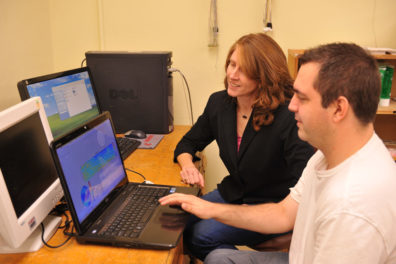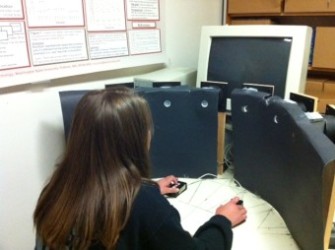Current Research Projects

Action Planning and Perception.
Everyday actions such as turning on an appliance, starting your car, and programming your television remote require the production of action plans. Sometimes we have to momentarily suspend the execution of one action plan in order to execute another. Recent research suggests that execution of an action, at least in some cases, can be adversely affected by a planned action currently held in working memory (See Hommel et al., 2001 for a review). Our laboratory is presently investigating the conditions in which a planned action currently held in working memory can interfere with execution of other actions. Our long-term goal is to understand how action plans are constructed and selected.
To investigate how holding an action plan in memory can affect other actions, we are using a paradigm adopted by Stoet and Hommel (1999). In this paradigm, two stimuli are presented sequentially. A response is planned and withheld to the first stimulus, and a response is executed immediately to the second stimulus. After responding quickly to the second stimulus, one must accurately execute the action remembered to the first stimulus. It has been shown that when the withheld action shares a “feature” with the intervening action, execution of the intervening action is delayed. This is referred to as Compatibility Interference (CI) or Partial Repetition Costs (PRC).
We are investigating what constitutes a “feature” within an action plan– that is, how are features represented? How are action features linked together? How might action and perceptual features be integrated? How do internally generated actions differ from externally generated actions? We are also investigating under what action conditions partial repetition costs (PRCs) do not occur. Finally, we are investigating differences between actions that depend more on ventral vs. dorsal stream processing within brain, differences between actions that can be executed automatically vs. those that require more cognitive control, and differences in action control between the two brain hemispheres.
Most recently we are working on questions such as: Does memory span affect action representation? Are action sequences represented by a gradient of activation in working memory? Are mirror neurons important for learning actions to non-biological stimuli? How do action plans in different memory stores interact?
Relevant Publications:
Fournier, L.R., & Richardson*, B., & Logan, G. (Accepted June 3, 2022). Partial repetition costs are reduced but not eliminated with practice. Journal of Cognition
Fournier, L.R. & *Richardson, B.P. (2022). Partial repetition between action plans delays responses to ideomotor compatible stimuli, Psychological Research, 86, 627-641. https://doi.org/10.1007/s00426-021-01491-9 (shareable paper at link: https://rdcu.be/cg7nz )
*Richardson, B., Pfister, R., & Fournier, L.R. (2020, online). Free-Choice and forced-choice actions: Shared representations and conservation of cognitive effort. Attention, Perception & Psychophysics, 82, 2516–2530. https://doi.org/10.3758/s13414-020-01986-4
Fournier, L.R., *Hansen, D.A., *Stubblefield, A.M., & Van Dongen, H.P.A. (2020). Action plan interrupted: Resolution of proactive interference while coordinating execution of multiple action plans during sleep deprivation. Psychological Research, https://doi.org/10.1007/s00426-018-1054-z
*Behmer Jr., L.P., & Fournier, L.R. (2016). Mirror neuron activation as a function of explicit learning: Changes in mu-event related power after learning novel responses to ideomotor compatible, partially compatible, and non-compatible stimuli. European Journal of Neuroscience, 44, 2774-2785.
Fournier, L.R., *Wiediger, M.D., & *Taddese, E.F. (2015). Action plans can interact to hinder or facilitate reach performance. Attention, Perception & Psychophysics, 77, 2755-2767. DOI: 10.3758/s13414-015-0959-5.
Fournier, L.R., *Behmer Jr., L.P., & *Stubblefield, A.M. (2014). Interference due to shared features between action plans is influenced by working memory span. Psychonomic Bulletin & Review, 21, 1524-1529. DOI: 10.3758/s13423-014-0627-0.
Pfister, R., Janczyk, M., Gressmann, M., Fournier, L.R., & Kunde, W. (2014). Good vibrations? Vibrotactile self- stimulation reveals anticipation of body-related action effects in motor control. Experimental Brain Research, 232, 847-854. DOI: 10.1007/s00221-013-3796-6.
Behmer, L.P. Jr., Fournier, L.R. (2014). Working Memory Modulates Neural Efficiency Over Motor Components During a Novel Action Planning Task: An EEG Study. Behavioural Brain Research, 260, 1-7. DOI: 10.1016/j.bbr.2013.11.031
Fournier, L.R., Behmer, L.P., Stubblefield, A.M. (in press, 2014). Interference due to shared features between action plans is influenced by working memory span. Psychonomic Bulletin & Review, DOI: 10.3758/s13423-014-0627-0
Fournier, L. R., Gallimore, J. M., Feiszli, K. R., & Logan, G. D. (2014). On the importance of being first: Serial order effects in the interaction between action plans and ongoing actions. Psychonomic Bulletin & Review, 21,163-169. DOI:10.3758/s13423-013-0486-0
Fournier, L. R., & Gallimore, J. M. (2013). What makes an event: Temporal integration of stimuli or actions?. Attention, Perception, & Psychophysics, 75, 1-13.
Patterson, R.E., Fournier, L.R., Williams, L., Amann, R., Tripp, L., Pierce, B., (2013). System dynamics modeling of sensory-driven decision priming. Journal of Cognitive Engineering and Decision Making, 7, 3-25.
Mattson, P. S., Fournier, L. R., & Behmer, L. (2012). Frequency of the first feature in action sequences influences feature binding. Attention, Perception, & Psychophysics, 1-15. DOI: 10.3758/s13414-012-0335-7.
Fournier, L. R., Wiediger, M. D., McMeans, R., Mattson, P. S., Kirkwood, J., & Herzog, T. (2010). Holding A Manual Response Sequence In Memory Can Disrupt Vocal Responses That Share Semantic Features With the Manual Response, Psychological Research, 74, 359-369.
Wiediger, M. D. & Fournier, L. R. (2008). An Action Sequence Withheld in Memory Does Not Necessarily Delay Execution of a Similar Action: An Investigation of Compatibility Interference. Journal of Experimental Psychology: Human Perception & Performance, 34, 1136-1149.
Mattson, P. S. & Fournier, L. R. (2008). An action sequence held in memory can interfere with response selection of a target stimulus, but does not interfere with response activation of noise stimuli. Memory & Cognition, 36, 1236-1247.
PRECRASTINATION.
Putting things off as long as possible (procrastination) is a well-known tendency. Less well known is the tendency to start or finish things as soon as possible (precrastination). When ordering tasks, people and other animals tend to first perform the task that can be started or completed sooner (precrastination) even if it requires more physical effort. Evidence (from transport tasks in our lab) suggests that precrastination can reduce cognitive effort and will likely not occur if it increases cognitive effort. Our laboratory is currently exploring other factors that contribute to precrastination including those underlying individual differences. Understanding precrastination will have important implications for explaining why hurrying happens as often as it does and may help reduce the chance that haste makes waste. Understanding precrastination may also help reduce hurrying that can lead to risky behaviors.
Relevant Publications:
*Nisha Raghunath, N., Fournier, L.R., & Kogan, C. (2020, online). Precrastination and individual differences in working memory, Psychological Research, 85, 1970-1985. https://doi.org/10.1007/s00426-020-01373-6
Rosenbaum, D.A., Fournier, L.R., Levy-Tzedek, S., McBride, Rosenthal, R., *Saurberger, K., *VonderHaar, R.L., Wasserman, E.A., Zentall, T.R. (2019, online). Sooner rather than later: Precrastination rather than procrastination. Current Directions in Psychological Science, https://doi.org/10.1177/0963721419833652
Fournier, L.R., *Stubblefield, A.M., Dyre, B.P., & Rosenbaum, D.A. (2019). Starting or finishing sooner? Sequencing preferences in object transfer tasks. Psychological Research, 83(8), 1674-1684. https://doi.org/10.1007/s00426-018-1022-7
Fournier, L.R., **Coder, E., Kogan, C., *Nisha Raghunath, N., *Taddese, E., & Rosenbaum, D.A. (2019) Which task will we choose first? Precrastination and cognitive load in task ordering. Attention, Perception & Psychophysics, 81(2), 489-503. https://doi.org/10.3758/s13414-018-1633-5
Within-Object Feature Selection.
We are examining a phenomenon we term “conjunction benefits” which is defined as a speed up in identification performance when multiple features must be identified within an object relative to a single feature. We have ruled out several explanations of “conjunction benefits”, and have shown that identifying multiple features within an object does not increase the perceptual demands on attention. Also, we have shown that conjunction benefits occur only for features within a single object, when each feature varies in discriminability, and only when each feature can contribute independently to a response decision. We are presently examining the limitations and generalization of this phenomenon and its implications for other models of attention and visual information processing.
Relevant Publications:
Patterson, R.E., Fournier, L.R., Williams, L., Amann, R., *Tripp, L., Pierce, B., (2013). System dynamics modeling of sensory-driven decision priming. Journal of Cognitive Engineering and Decision Making, 7, 3-25.
Patterson, R. Fournier, L., Pierce, B., Winterbottom, M., & Tripp, L. (2009). System dynamics modeling of the time course of the recognition-primed decision model, Journal of Cognitive Engineering and Decision Making 3, 250-276.
Fournier, L. R., Patterson, R., Dyre, B. P., Wiediger, M., & Winters, R. (2007). Conjunction benefits and costs reveal decision priming for first- and second-order features. Perception & Psychophysics, 69(8), 1409-1421.
Fournier, L. R., Herbert, R. J., Farris, C. (2004). Demands on Attention and the Role of Response Priming in Visual Discrimination of Feature Conjunctions. Journal of Experimental Psychology: Human Perception and Performance, 30(5).
Fournier, L. R., Scheffers, M. K., Coles, M. G. H., Adamson, A. L., Vila, E. (2000). When complexity helps: An electrophysiological analysis of multiple feature benefit in object perception. Acta Psychologica 104, 119-142.
Fournier, L. R., Bowd, C., & Herbert, R. (2000). Interference from multi-dimensional objects during feature and conjunction discrimination. Quarterly Journal of Experimental Psychology, 53A(1), 191-209.
Fournier, L. R., Eriksen, C. W., & Bowd, C. (1998). Multiple feature discrimination faster than single feature discrimination within the same object? Perception & Psychophysics, 60, 1384-1405.
Collaborative Research:
In collaboration with Dr. Robert Patterson, and others at the U.S. Air Force Research Lab in Dayton, Ohio, we are investigating the phenomenon of conjunction benefits (described above) in real-world scenarios. We are also using system dynamics modeling to represent how decision priming by relevant information can affect final decision making processes. We are currently broadening our research focus to include action planning (including the CI phenomenon described above) and the utility of implicit vs. explicit decision making in real-world environments. Our lab currently has an Educational Partnership Agreement with the U.S. Air Force which has supported the high-tech equipment required to simulate many of the real-world displays.
Relevant Publications:
Patterson, R.E., Fournier, L.R., Williams, L., Amann, R., *Tripp, L., Pierce, B., (2013). System dynamics modeling of sensory-driven decision priming. Journal of Cognitive Engineering and Decision Making, 7, 3-25.
Patterson, R., Fournier, L., Williams, L., Amann, R., Tripp, L., Pierce, B., (2012). System dynamics modeling of sensory-driven decision priming. Journal of Cognitive Engineering and Decision Making. doi: 10.1177/1555343412445474
Patterson, R. Fournier, L., Pierce, B., Winterbottom, M., & Tripp, L. (2009). System dynamics modeling of the time course of the recognition-primed decision model, Journal of Cognitive Engineering and Decision Making 3, 250-276.
Other Research Interests Reflected in Publications
Research Methods:
Most of our experiments utilize static, 2-D visual displays in which we measure response times and response accuracy in identifying visual stimuli. However, we are also utilizing psychophysiological measures including EEG and EMG. In some of our collaborative research, we use dynamic displays on large screens that simulate movement through a real-world environment. We are currently using gaming software (X-Plane) in some of our research as well.






